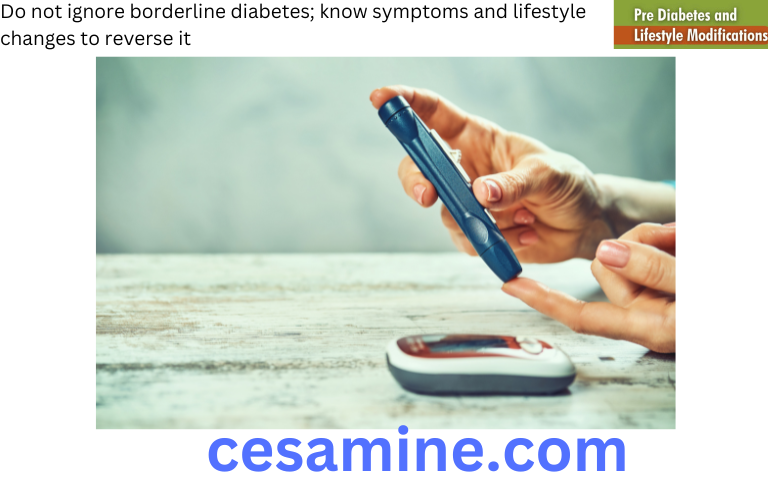Borderline diabetes and prediabetes are interchangeable terms for the same condition. Although some people who have it go on to develop type 2 diabetes, not everyone who has it does. Simply explained, prediabetes is a medical condition in which your blood sugar levels are elevated but not high enough to be classified as type 2 diabetes. The good news is that it is highly reversible, so all you need to do to prevent metabolic disease is adopt some healthy lifestyle choices and maintain them.
Diabetes is a long-term medical disorder in which the body has trouble using and storing glucose, the primary fuel for the body. Insulin resistance, or the inability to produce enough insulin to control blood sugar levels, is a defining characteristic of type 2 diabetes, which is brought on by a combination of hereditary and environmental factors. You may have borderline diabetes or prediabetes for years without knowing it because these are typically asymptomatic conditions. Your risk of developing type 2 diabetes, heart disease, and stroke may increase. A routine health examination is necessary to detect prediabetes if you have risk factors for diabetes.

Although the term borderline diabetes is not used in scientific literature, pre-diabetes, also known as ‘borderline diabetes,’ is a condition that can develop before type 2 diabetes and increases one’s risk of developing type 2 diabetes. Fortunately, the progression from pre-diabetes to diabetes is not inevitable. Many people, according to research, can stop the progression from borderline diabetes.
What Is Borderline Diabetes, Exactly?
According to Dr. V. Mohan, Chairman and Chief Diabetologist, “Borderline diabetes is a condition in which blood sugar levels are higher than normal but not high enough to be classified as diabetes. For example, if your fasting blood glucose level is greater than or equal to 126 mg/dl, you are considered to have diabetes, while you are considered normal if your fasting blood glucose is below 100 mg/dl. Therefore, if your fasting blood sugar is 120 mg/dl.
What Signs Might Be Present?
According to Dr. V. Mohan, borderline diabetes can only be identified through a blood test and is almost always asymptomatic.
According to the diabetologist, if the problem worsens and becomes overt diabetes, a person may suffer symptoms like:
- Continual urination
- A growing thirst
- Increased appetite
- Tiredness
- Vision haze
- Tingling or numbness in the hands or feet
- Delayed healing of wounds
Why Is It Dangerous To Have Borderline Diabetes?
According to Dr. Mohan, borderline diabetes is a symptom that type 2 diabetes, a more dangerous illness, may develop in the future. A third of those with borderline diabetes get diabetes, and Indians are more likely and at a higher risk of doing so. Additionally, if you have borderline diabetes plus additional risk factors like high cholesterol, high blood pressure, or smoking, you are more likely to develop cardiovascular disease (heart and blood vessel disease).
How Is Diabetes Borderline Diagnosed?
A blood glucose test is required for the diagnosis of borderline diabetes. A fasting blood glucose test, a glucose tolerance test, or a HbA1c test can all be done. It might be necessary to perform the test several times in order to confirm the diagnosis.
Who Ought To Take These Exams?
You should consider getting yourself evaluated if you have diabetes risk factors. These consist of
- Having a weight problem
- Growing old
- Having a family history of diabetes
- Having a big child or having diabetes while pregnant.
“The Indian Diabetes Risk Score (IDRS) is a useful tool for assessing a person’s risk of developing diabetes. The risk score is calculated by responding to four questions and measuring your waist with an inch tape. If your scores are 60 or higher, you should have a blood test to determine whether you have diabetes or borderline diabetes,” advises Dr. Mohan.
How Is Managing Borderline Diabetes Done?
No matter how likely it is that you may develop diabetes in the future, living a healthy lifestyle can reduce your pre-diabetes risk. Additionally, it may help to halt the progression of borderline diabetes and reverse it, returning it to normal.
Changing Your Lifestyle Can Reverse Borderline Diabetes.
Umasakthy, a dietician, advises making certain healthy lifestyle adjustments to reverse prediabetes.
- Eat wholesome foods.
- Continue engaging in regular exercise
- If you are overweight, start a weight loss programme.
In a similar vein, reducing carbohydrate intake, increasing protein intake, and switching to healthy fats can help to return borderline diabetes to its normal state. Medication may also help in some cases. You can talk to your diabetologist for help. “It has been demonstrated that losing as little as 5% of one’s body weight can reduce the risk of development of diabetes from borderline diabetes.